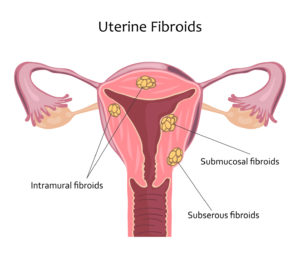 Fibroids (also called leiomyoma) are a common gynecologic condition. They are a benign tumour of the smooth muscle of the uterus, essentially a little (or sometimes big!) ball of muscle. Although many women have fibroids, most women are not bothered by them. It is very common to see small fibroids (1-5cm) on ultrasounds of women who are not having any symptoms. These do not require any treatment.
Fibroids (also called leiomyoma) are a common gynecologic condition. They are a benign tumour of the smooth muscle of the uterus, essentially a little (or sometimes big!) ball of muscle. Although many women have fibroids, most women are not bothered by them. It is very common to see small fibroids (1-5cm) on ultrasounds of women who are not having any symptoms. These do not require any treatment.
Depending on the location, the size, and how many there are, some women may have symptoms related to their fibroids. Most commonly if women have symptoms from their fibroids, they include heavy bleeding and/or pelvic pressure. If a fibroid puts pressure on the bladder, urinary frequency can result. If a fibroid becomes large, sometimes it can twist, or the center can degenerate or bleed, and this can cause pain. Fibroids in a location that impinges on the inside of the uterus where a baby develops may have fertility issues.
Treatment is only required if a woman is experiencing significant enough symptoms to warrant it. Treatment options include:
- Ulipristal Acetate (Fibristal): This is a medication that can be taken for three months at a time, and treatment courses can be repeated as needed. It is very effective at reducing the bleeding associated with fibroids, and can help to shrink fibroids as well.
- GnRH agonists (Depot Lupron): These are medications that essentially induce a 'medical menopause' and as such are very effective at reducing bleeding associated with fibroids. They also help to shrink fibroids. However, because they induce menopause, the side effects can be limiting and include hot flashes and risks for bone health with prolonged use. For this reason, this medication is often used for short periods of time before surgery in order to shrink the fibroids to make surgery less challenging and reduce blood loss at surgery. If prolonged use of the medication is desired, replacement estrogen and progesterone can be used to mitigate side effects.
- Uterine Artery Embolization: This is a procedure done by interventional radiology where the blood supply to the fibroid is isolated and reduced or eliminated in order to shrink the fibroid and thereby reduce the symptoms associated with it. It is not a surgery, in that no general anesthetic is required to do the procedure, but a one night stay in hospital to control pain afterwards is usual. Recovery time is fairly short.
- Myomectomy: This is a surgery done to remove the fibroid without removing the uterus. Depending on the location of the fibroid this may be an abdominal surgery, or it can be a hysteroscopic surgery (done inside the uterus by going through the cervix, without an incision on the abdomen). This is generally only done for women who still wish to have pregnancies.
- Hysterectomy: This is a surgery to remove the uterus along with any associated fibroids. Large fibroids can make this surgery very difficult, and can prevent it from being done in a minimally invasive technique, and so sometimes medication to shrink the fibroid will be given for 3-6 months before surgery.